Neurodiagnostics Market Size and Trends
The neurodiagnostics market is estimated to be valued at USD 9.38 Bn in 2025 and is expected to reach USD 16.40 Bn by 2032, exhibiting a compound annual growth rate (CAGR) of 8.3% from 2025 to 2032.
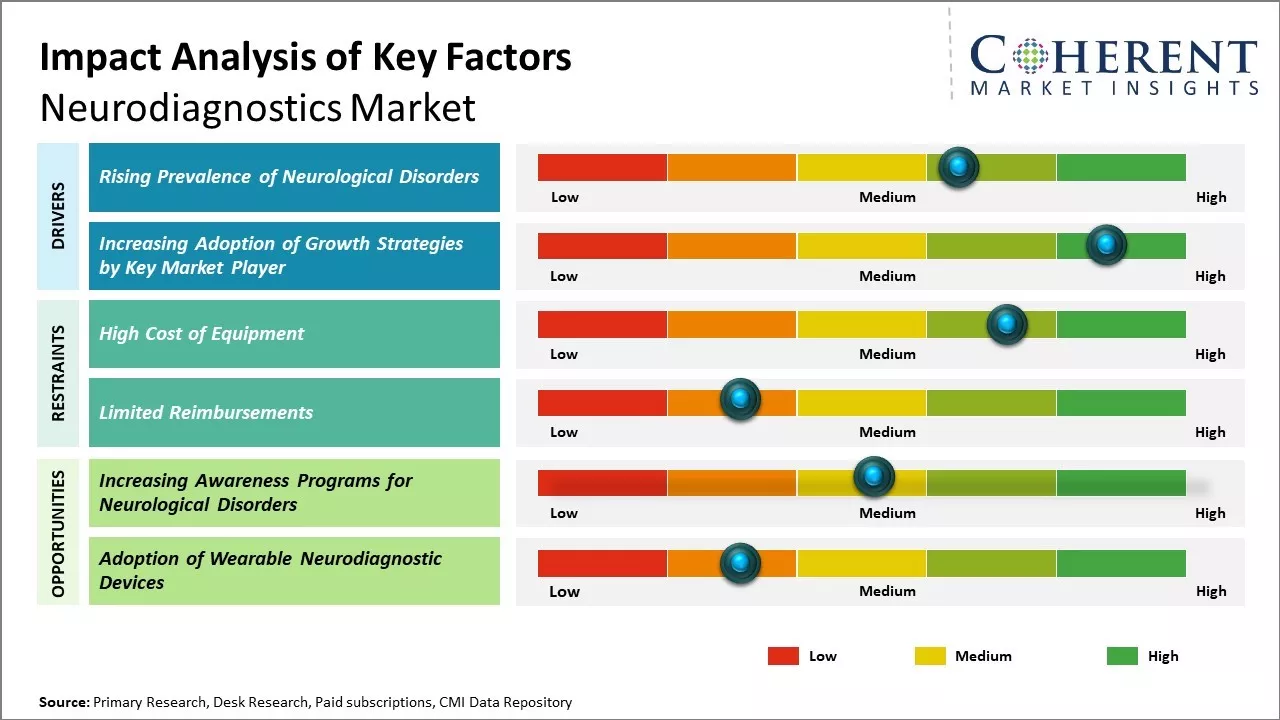
Discover market dynamics shaping the industry: Download Free Sample
The neurodiagnostics market is expected to witness positive growth over the forecast period. The growing geriatric population and rising global disease burden of neurodegenerative and neurological disorders are the major factors that are expected to drive the market growth. In addition, technological advancements in neurodiagnostics testing and imaging modalities along with growing awareness regarding early disease diagnosis are further expected to support the market growth between 2025 and 2032. However, high cost of advanced neurodiagnostic tests may hinder the market growth to some extent over the coming years.
Market Driver – Rising Prevalence of Neurological Disorders
Neurological conditions, such as Alzheimer's disease, Parkinson's disease, epilepsy, multiple sclerosis, stroke, and traumatic brain injuries, are affecting a significant proportion of the population worldwide. It is estimated that around 50 million people are suffering from dementia globally and the number is expected to triple by 2050. The increasing prevalence of as Alzheimer's disease, Parkinson's disease, epilepsy can be attributed to both genetic and environmental factors. With increasing age comes an increased risk of neurological dysfunction. As life expectancy improves across countries, aging populations are more susceptible to these conditions. Moreover, modern lifestyles with less physical activity, poor dietary habits, and higher stress levels are contributors. Exposure to toxic substances, head injuries, and neurological infections also add to the rising disease burden. This massive patient pool needs effective diagnosis and monitoring of their conditions. Neurodiagnostics devices come handy for doctors in studying the structure and function of the nervous system. Devices like magnetic resonance imaging systems, computed tomography scanners, electroencephalogram (EEG) machines, ultrasound scanners, and molecular testing kits are indispensable tools for identifying the underlying cause of symptoms and deciding on the right course of treatment.
Market Concentration and Competitive Landscape
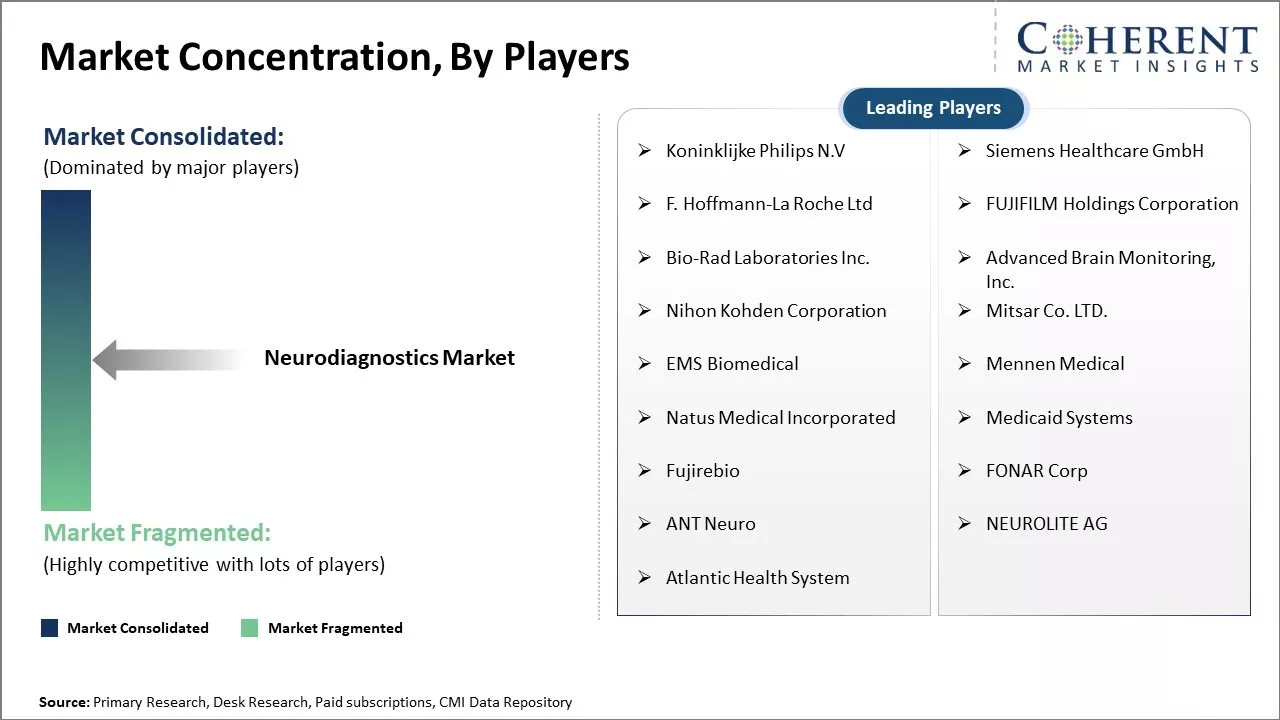
Get actionable strategies to beat competition: Download Free Sample
Market Driver – Increasing Adoption of Growth Strategies by Key Market PlayerThe increasing adoption of inorganic growth strategies, such as agreements, by key market players to develop advanced neurodiagnostics systems is expected to drive the global neurodiagnostics market growth over the forecast period. For instance, in November 2022, DiagnaMed Holdings Corp., a medical technology company, announced an agreement with KU Center for Technology Commercialization at the University of Kansas, U.S., to develop a new virtual reality (VR) and artificial intelligence (AI) neurodiagnostic system (VR/AI Neuro). The VR/AI Neuro system is designed for assessing, diagnosing, and monitoring neurodegenerative diseases, including Parkinson’s disease.
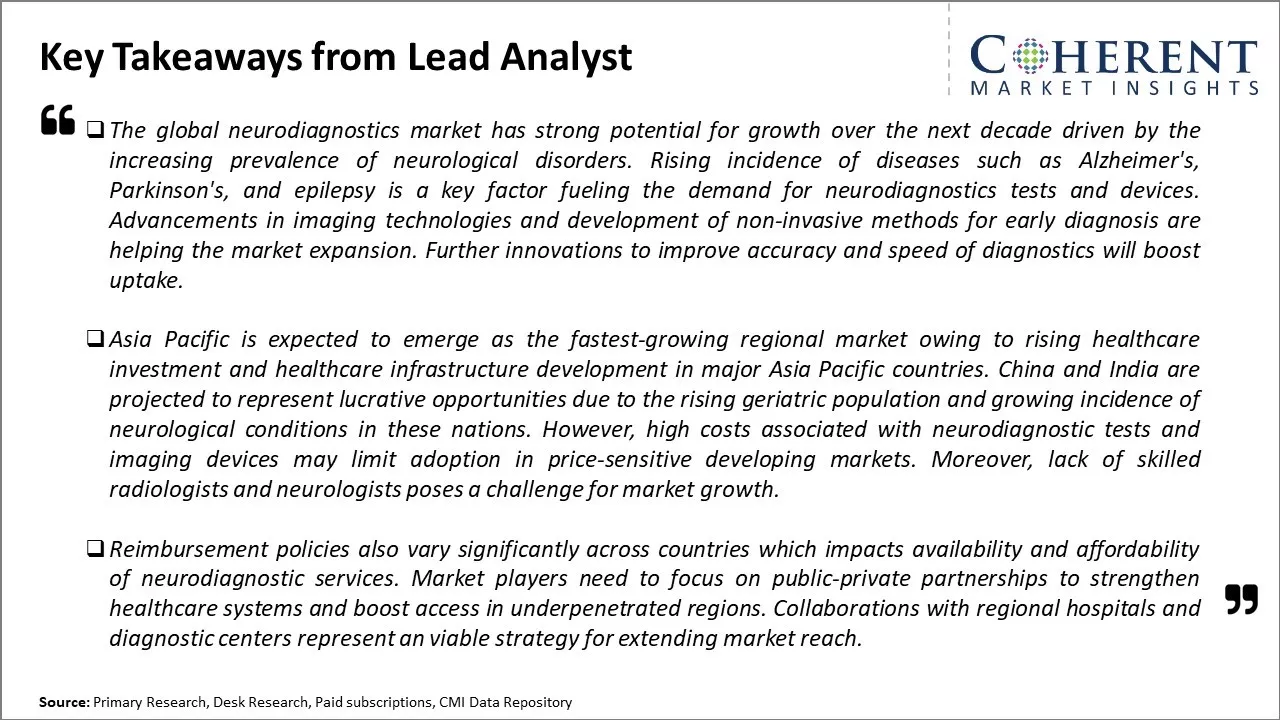
To learn more about this report, Download Free Sample
Market Challenges – High Cost of EquipmentThe high cost of equipment hinders wider adoption rates across healthcare facilities. Furthermore, a shortage of skilled professionals trained to operate advanced diagnostic tools poses a hurdle. Reimbursement policies for expensive tests vary significantly globally, affecting return on investment. Persistent technological challenges in certain areas like brain mapping add to the research costs. Overall, achieving economies of scale due to the specialized nature and demand variability within the industry influences profit margins.
Market Opportunities – Increasing Awareness Programs for Neurological Disorders
Increasing growth strategies such as launch of awareness programs by key market players offers lucrative opportunities for the global neurodiagnostics market. For instance, in May 2022, St. Rita’s Medical Center announced the launch of a new Ceribell Rapid EEG Brain Monitoring program to ensure that optimal care is provided to critically ill patients. The Rapid EEG is providing a vital sign for brain function.
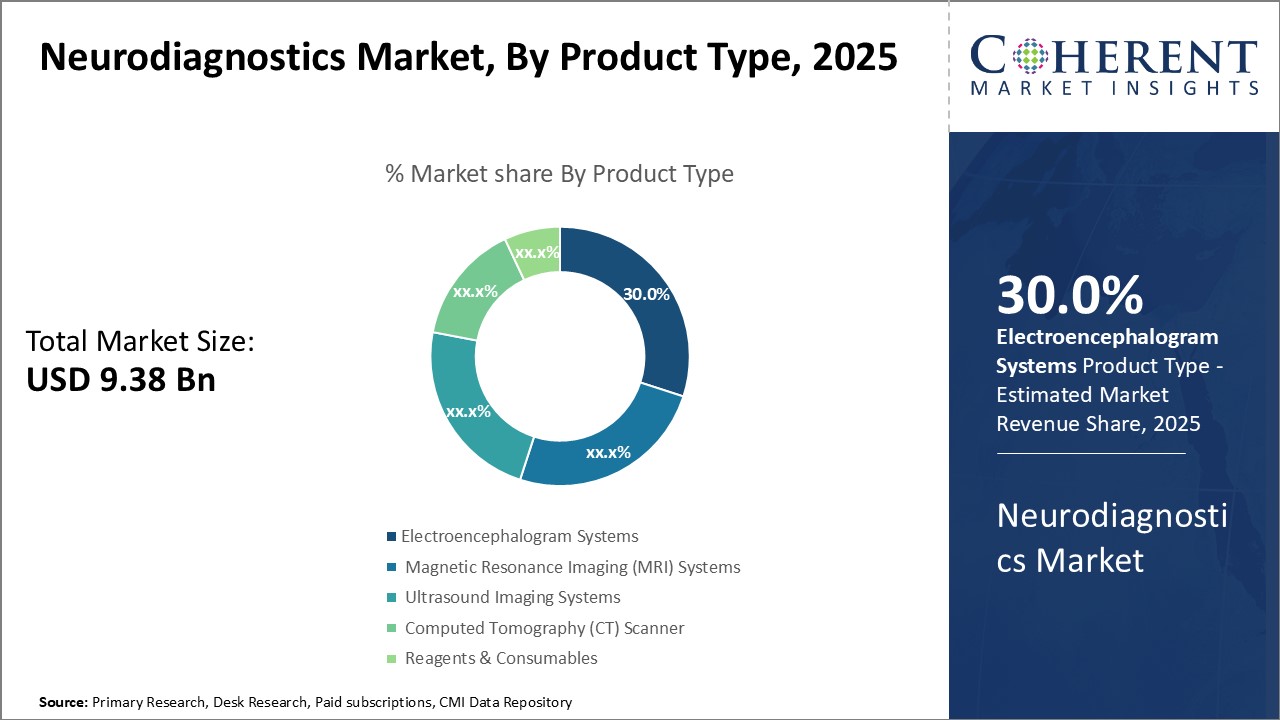
Discover high revenue pocket segments and roadmap to it: Download Free Sample
Insights, By Product Type: Early Detection of Neurological Disorders Drives the Demand for EEG SystemsThe product type segment includes electroencephalogram (EEG) systems, magnetic resonance imaging (MRI) systems, ultrasound imaging systems, computed tomography (CT) scanner, reagents & consumables, and others. The electroencephalogram (EEG) systems segment is estimated to hold 30.0% share of the market in 2025 owing to its ability to detect neurological disorders at an early stage. EEG systems help scan the brain's electrical activity and detect even subtle changes caused by conditions like seizures, head injuries, brain tumors, and sleep disorders. The non-invasive nature and portability of EEG systems make them suitable for the continuous monitoring of patients, especially children. EEG findings can guide physicians towards a confirmatory diagnosis and appropriate treatment plan. This early diagnosis helps curb the progression of neurological damage and improves patient outcomes. Furthermore, ambulatory EEG systems allow for long-term monitoring in a real-world setting outside of hospitals and labs. This helps physicians better understand how neurological events manifest over extended periods. The growing preference for non-invasive diagnostics and emphasis on early intervention support the higher adoption of EEG systems compared to other neurodiagnostic modalities.
Insights, By Therapeutic Area: Rising Prevalence of Neurodegenerative Diseases
The therapeutic area segment includes neurodegenerative diseases, sleep disorders, stroke, epilepsy, and others. The neurodegenerative diseases subsegment is expected to account for 52.9% of the market share in 2025 owing to rising prevalence of neurodegenerative diseases such as Alzheimer's disease and Parkinson's disease. Neurodegeneration leads to the gradual loss of structure or function of neurons, including those in the brain and spinal cord. Physicians rely on neurodiagnostic tests to detect changes in the brain that are characteristic of neurodegenerative diseases. This helps achieve confirmatory diagnosis and monitor progression and treatment response over time. As there are currently no cures for major neurodegenerative diseases, diagnostic testing assumes great importance to facilitate drug development and advances in treatment approaches. The growing clinical focus on neuroinflammation as a driver of neurodegeneration also boosts the clinical need for neuroimaging and cerebrospinal fluid analysis via this market segment.
Insights, By End User: Availability of Advanced Neurodiagnostic Modalities and Expertise
The end user segment includes hospitals, diagnostic centers, ambulatory care centers, and others. The hospitals subsegment is expected to hold 34.2% of the market share in 2024 due to the availability of advanced neurodiagnostic modalities and expertise in clinically complex areas like neurosurgery and neurology. Most patients rely on hospital facilities for MRI, CT, EEG, and lumbar puncture procedures required to investigate neurological symptoms and events. The high infrastructure investments made towards neurodiagnostic departments by hospitals attract more complex referral cases. Hospitals also have well-established neurology specialty services that regularly utilize objective test findings to refine clinical management for inpatients and outpatients. This promotes the higher uptake of neurodiagnostic services among hospitals.
Regional Insights
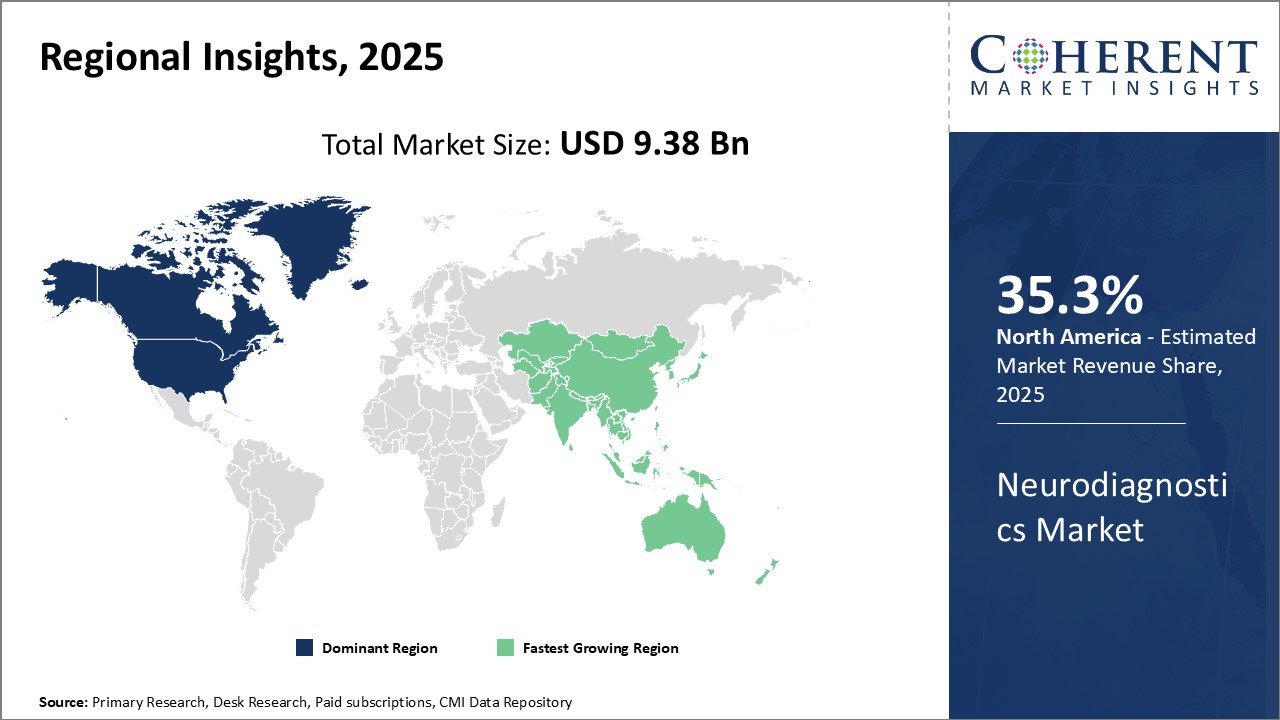
Need a Different Region or Segment? Download Free Sample
North America remains the dominant region in the global neurodiagnostics market and is anticipated to hold 35.3% of the market share in 2025. The major factor contributing to its leadership position is the presence of a well-established healthcare infrastructure and advanced technologies in countries like the U.S. and Canada. These countries have been early adopters of new neurodiagnostics technologies due to strong demand. They also provide favorable reimbursement policies, facilitating wider adoption of such technologies. North America has a large number of leading neurodiagnostics device manufacturers such as GE Healthcare, Philips Healthcare, Siemens Healthineers, etc. The strong in-house manufacturing base creates easy accessibility to a wide range of advanced neurodiagnostic devices. It also allows local companies to continuously invest in research and development to introduce innovative products in the market. This has ensured that North America is at the forefront of introducing new technologies like portable or wearable neuromonitoring devices.
The Asia Pacific region has been witnessing strong growth in the neurodiagnostics market over the past few years. Major factors driving the market expansion are rising incidence of neurodegenerative diseases, growing health awareness, expanding healthcare infrastructure, and increasing disposal incomes in developing countries like China, India, and other Asian economies. The neurodiagnostics market is attracting significant investments from global as well as local medical device manufacturers to tap growth opportunities in this region. Several companies have set up manufacturing facilities or partnered with local players. This has increased availability and access to advanced neurodiagnostics solutions. Additionally, favorable government initiatives aimed at making healthcare more affordable and accessible are facilitating the wider adoption of neurodiagnostics across Asia Pacific. This positions the region as one of the fastest growing markets for neurodiagnostics globally.
Market Report Scope
Neurodiagnostics Market Report Coverage
| Report Coverage | Details | ||
|---|---|---|---|
| Base Year: | 2024 | Market Size in 2025: | USD 9.38 Bn |
| Historical Data for: | 2020 To 2024 | Forecast Period: | 2025 To 2032 |
| Forecast Period 2025 to 2032 CAGR: | 8.3% | 2032 Value Projection: | USD 16.40 Bn |
| Geographies covered: |
|
||
| Segments covered: |
|
||
| Companies covered: |
Koninklijke Philips N.V, Siemens Healthcare GmbH, F. Hoffmann-La Roche Ltd, FUJIFILM Holdings Corporation, Bio-Rad Laboratories Inc., Advanced Brain Monitoring, Inc., Nihon Kohden Corporation, Mitsar Co. LTD., EMS Biomedical, Mennen Medical, Natus Medical Incorporated, Medicaid Systems, Fujirebio, FONAR Corp, ANT Neuro, NEUROLITE AG, and Atlantic Health System |
||
| Growth Drivers: |
|
||
| Restraints & Challenges: |
|
||
Uncover macros and micros vetted on 75+ parameters: Get instant access to report
Market Segmentation
- Product Type Insights (Revenue, USD Bn, 2020 - 2032)
- Electroencephalogram (EEG) Systems
- Magnetic Resonance Imaging (MRI) Systems
- Ultrasound Imaging Systems
- Computed Tomography (CT) Scanner
- Reagents & Consumables
- Others
- Therapeutic Area Insights (Revenue, USD Bn, 2020 - 2032)
- Neurodegenerative Diseases
- Sleep Disorders
- Stroke
- Epilepsy
- Others
- End User Insights (Revenue, USD Bn, 2020 - 2032)
- Hospitals
- Diagnostic Centers
- Ambulatory Care Centers
- Others
- Regional Insights (Revenue, USD Bn, 2020 - 2032)
- North America
- U.S.
- Canada
- Latin America
- Brazil
- Argentina
- Mexico
- Rest of Latin America
- Europe
- Germany
- U.K.
- Spain
- France
- Italy
- Russia
- Rest of Europe
- Asia Pacific
- China
- India
- Japan
- Australia
- South Korea
- ASEAN
- Rest of Asia Pacific
- Middle East
- GCC Countries
- Israel
- Rest of Middle East
- Africa
- South Africa
- North Africa
- Central Africa
- North America
- Key Players Insights
- Koninklijke Philips N.V
- Siemens Healthcare GmbH
- F. Hoffmann-La Roche Ltd
- FUJIFILM Holdings Corporation
- Bio-Rad Laboratories Inc.
- Advanced Brain Monitoring, Inc.
- Nihon Kohden Corporation
- Mitsar Co. LTD.
- EMS Biomedical
- Mennen Medical
- Natus Medical Incorporated
- Medicaid Systems
- Fujirebio
- FONAR Corp
- ANT Neuro
- NEUROLITE AG
- Atlantic Health System
Share
Share
About Author
Manisha Vibhute is a consultant with over 5 years of experience in market research and consulting. With a strong understanding of market dynamics, Manisha assists clients in developing effective market access strategies. She helps medical device companies navigate pricing, reimbursement, and regulatory pathways to ensure successful product launches.
Missing comfort of reading report in your local language? Find your preferred language :
Transform your Strategy with Exclusive Trending Reports :
Frequently Asked Questions
EXISTING CLIENTELE
Joining thousands of companies around the world committed to making the Excellent Business Solutions.
View All Our Clients
